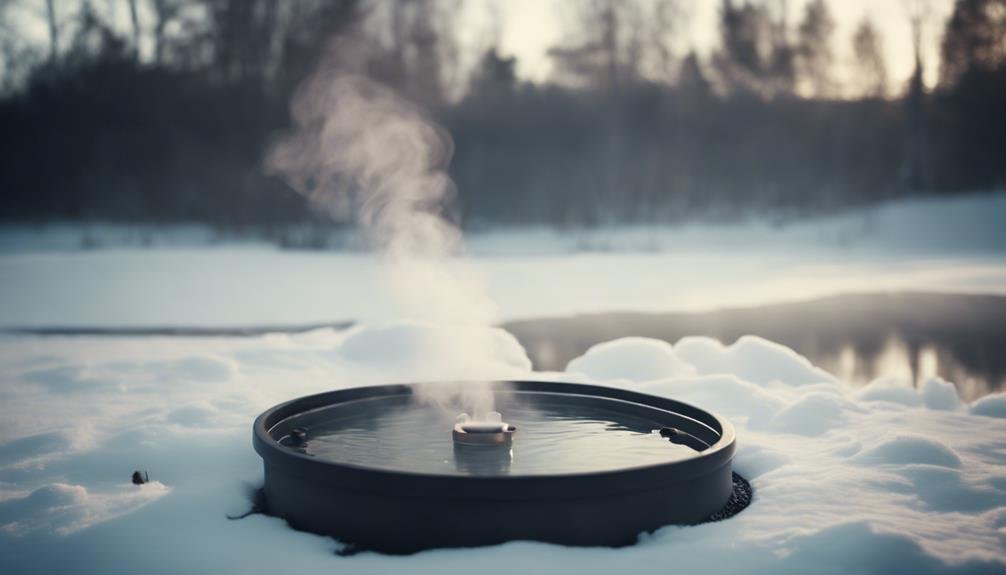When preparing for winter, it’s wise to select energy-efficient pond heaters with thermostat controls to maintain a suitable environment. These heaters are submersible, equipped with titanium elements that heat up quickly and automatically adjust to set temperatures, reducing energy usage.
Floating heaters or de-icers offer a budget-friendly option to prevent surface freezing. Safety features like anchors and GFCI outlets ensure proper operation. Remember to match the wattage and capacity of the heater to your pond size and local climate. Insulation can also help decrease heating requirements.
For personalized recommendations based on your needs, let’s take a closer look at the top-rated pond heaters available on the market.
Energy-Efficient Heaters
Concerned about saving on energy costs while ensuring your fish’s well-being in winter? Opting for energy-efficient pond heaters is the smart choice. These heaters are designed to consume less electricity while still effectively maintaining a suitable water temperature for your fish.
Let’s explore some top energy-efficient options available in the market.
One excellent choice is the titanium heating element, known for its quick heating capabilities and ability to sustain a consistent temperature with minimal energy consumption. Another efficient option is a de-icer or floating heater, which warms only a small area to prevent ice buildup while using minimal power. Submersible heaters with built-in thermostats are also energy-efficient, as they regulate their on/off cycles based on the required water temperature.
When selecting an energy-efficient heater, consider factors such as pond size, local climate conditions, and the desired temperature range for your fish. Some models offer various wattage options to customize energy usage.
Additionally, proper insulation and using a pond cover can further decrease the need for excessive heating. By investing in the right energy-efficient heater, you can ensure your fish’s comfort without worrying about skyrocketing energy bills.
Submersible Pond Heaters
Submersible pond heaters with built-in thermostats are an excellent energy-efficient choice for keeping your pond warm during winter. These heaters are designed to be fully submerged in the water, ensuring direct heat transfer to the surrounding area. With an adjustable thermostat, you can easily set the desired water temperature, allowing the heater to run only when necessary to maintain that temperature.
It’s crucial to choose the right size and wattage based on your pond’s size and the climate of your region. Larger ponds or colder areas will require more powerful heaters to effectively regulate the water temperature. Quality submersible heaters are typically made from durable, waterproof materials like aluminum or stainless steel, ensuring they can withstand constant submersion and operate safely throughout the winter months.
By selecting the appropriate size and properly installing the heater, you can efficiently maintain a comfortable environment for your fish and plants during freezing weather. The built-in thermostat helps conserve energy by adjusting the heat output based on the water temperature, ultimately reducing operating costs compared to continuous heating.
Thermostat-Controlled Heaters

Thermostat-controlled heaters are a smart choice for maintaining optimal temperatures in your pond. These heaters automatically adjust the temperature, ensuring a comfortable environment for your aquatic life.
Not only do they provide precise temperature control, but they also help in saving energy and reducing utility costs. By investing in a thermostat-controlled heater, you can enjoy the convenience of a cost-effective solution that keeps your pond at the perfect temperature for your fish and plants to thrive.
Temperature Auto-Adjustment
Temperature auto-adjustment heaters, also known as thermostat-controlled heaters, are a convenient way to keep your pond’s water temperature steady within a desired range. They work by automatically turning on and off to regulate the water temperature, thanks to a built-in thermostat that lets you set the desired temperature range.
Once you’ve programmed it, the heater will activate when the water gets too cold, providing just enough heat to bring it back to the desired temperature. Conversely, it will deactivate when the water reaches the maximum temperature to prevent overheating.
The main benefit of these heaters is their consistency. You won’t have to constantly monitor and adjust the heating system manually, as it takes care of everything on its own. This ensures the ideal conditions for your fish and plants without the need for frequent temperature checks.
Additionally, by running only when necessary, thermostat-controlled heaters can be more energy-efficient compared to models that run continuously.
For a hassle-free way to heat your pond during winter, temperature auto-adjustment heaters are a low-maintenance and effective solution. Their thermostat control ensures precise temperature regulation, creating a stable environment for your aquatic ecosystem to thrive.
Energy Efficiency Ratings
Energy efficiency ratings offer valuable insights into the operating costs and environmental impact of thermostat-controlled pond heaters. These ratings are crucial indicators of a heater’s energy consumption and associated expenses. Opting for models with higher efficiency ratings can lead to significant cost savings in the long run.
Efficiency ratings are typically determined through standardized testing and are represented as a percentage or ratio. For instance, an 80% efficiency rating implies that 80% of the energy consumed is effectively converted into heat, with the remaining 20% being lost as waste heat. Choosing more efficient heaters can help minimize energy waste, resulting in lower utility bills and reduced environmental footprint.
When selecting a pond heater, it’s essential to consider its efficiency alongside factors like wattage output, temperature range, and safety features. Striving to find the most energy-efficient option that meets the heating requirements of your pond without compromising performance is key.
Seeking advice from experts can aid in making a well-informed decision that balances efficiency, cost-effectiveness, and environmental consciousness.
Floating Pond Heaters
Let’s delve into the world of floating pond heaters – a practical solution for keeping your water feature from freezing over during the winter months.
We’ll walk you through the simple installation process, the minimal maintenance requirements, and the crucial safety precautions to consider when using these heaters.
Ensuring proper setup and taking necessary precautions is key to preserving the health of your pond and ensuring your equipment operates efficiently throughout the colder seasons.
Installation and Maintenance
When setting up floating pond heaters, it’s crucial to ensure they’re installed correctly and well-maintained to guarantee optimal performance during the winter months. Let’s go over the essential steps to keep our heaters running smoothly and efficiently.
To start, place the heater strategically near the edge of the pond for easy access. Avoid placing it too close to overhanging trees or structures that could drip water and potentially cause damage. Securely anchor the unit using the provided rings or chains to prevent it from moving around.
Regular cleaning is key to maintaining the heater. Every few weeks, take the time to remove the heater and clean any debris or mineral buildup on the heating elements. This simple step helps maximize heat transfer and prevents damage. While the heater is out of the water, inspect the cord for any signs of fraying or damage that may require replacement.
Periodically test the thermostat to ensure it’s functioning correctly and cycling the heater on and off as needed to maintain the desired water temperature.
Power and Safety
When setting up floating pond heaters, it’s crucial to prioritize power and safety alongside proper installation and maintenance. To begin with, always opt for a heater specifically designed for outdoor and submersible use, ensuring it has the necessary electrical certification for safety.
Avoid any attempts to alter the electrical components, as this can lead to potential hazards like electric shocks or fires. Securely anchor the heater in the pond to prevent drifting or tipping, reducing the risk of accidents.
Regularly check the power cord for any signs of damage or wear, replacing it promptly if needed. Using a ground fault circuit interrupter (GFCI) outlet is advisable to safeguard against electrical shocks.
Never run the heater in low water levels or allow it to operate without water, as this may cause overheating and damage. Adequate water depth and circulation are essential for safe and efficient functioning.
Low-Wattage Heaters

Low-wattage pond heaters are a budget-friendly option for maintaining liquid water areas in small backyard ponds during the winter months. These heaters are designed to be energy-efficient, helping to sustain aquatic life while keeping utility expenses low.
Typically ranging from 100 to 500 watts, low-wattage pond heaters are ideal for smaller water features. They operate by utilizing a heating element submerged in the pond to gently warm the surrounding water, preventing complete freezing. While they may not prevent the entire pond from icing over, they create a crucial liquid zone that supports gas exchange and the survival of fish.
Choosing the right wattage for your pond’s size and the climate is essential. Insufficient wattage can result in the inability to maintain an opening in the ice, while excessive heat can waste energy and cause stress to aquatic inhabitants. Many models come equipped with thermostats for precise temperature control, adjusting the heat output automatically based on the ambient conditions.
When used correctly, low-wattage pond heaters offer an economical way to protect pond ecosystems from the harsh winter weather without causing a significant increase in energy costs. Proper sizing and installation following the manufacturer’s guidelines ensure optimal performance and efficiency.
De-Icer Pond Heaters
De-icer pond heaters are a powerful alternative to low-wattage heaters, as they actively generate heat to prevent surface freezing and maintain open water areas in ponds. These heaters operate by utilizing a heating element enclosed in a durable float, which heats the surrounding water when submerged, creating a zone free of ice. They come in varying wattages, from 300-1500W, allowing them to keep large areas of water open even in severe winter conditions. It’s important to note that due to their high energy consumption, de-icers can result in higher operating costs compared to low-wattage options.
When selecting a de-icer, the size of the unit is crucial. Higher wattage models can maintain larger ice-free areas but will consume more electricity. It’s essential to match the de-icer’s capacity to the surface area of your pond and the typical winter temperatures in your region.
Safety precautions such as using ground fault circuit interrupters and ensuring proper installation are vital to prevent electrical hazards. By choosing the right de-icer for your pond, you can enjoy a beautifully unfrozen water feature throughout the winter season.
Conclusion
In harsh winter conditions, a reliable pond heater is essential for ensuring the well-being of our koi fish.
Take, for example, our neighbor who utilized a 300W de-icer: her prized fish not only survived but thrived in temperatures as low as -10°C.
Given the wide range of energy-efficient options available on the market, investing in a high-quality heater is a smart choice for any pond owner looking to safeguard their aquatic environment.

